Erosion Performance of TiN/Ti Coatings under Different Nitrogen Flow Rates
Abstract
:1. Introduction
2. Materials and Methods
3. Results and Discussion
3.1. Phase Composition Analysis of TiN/Ti Multilayer Coatings
3.2. Surface of TiN/Ti Multilayer Coatings
3.3. Mechanical Properties of TiN/Ti Multilayer Coatings
3.4. Erosion Behavior of TiN/Ti Multilayer Coatings
3.5. Erosion Failure Process Analysis
4. Conclusions
- Nitrogen gas flow rate significantly affects the phase composition and mechanical properties of the coating: As the nitrogen gas flow rate increases, the phase composition of the coating transitions from TiN0.26 phase to a composite structure containing Ti2N and TiN, significantly enhancing the mechanical properties. The TiN/Ti coating prepared at a nitrogen gas flow rate of 16 sccm achieves peak hardness and elastic modulus values of 24.37 GPa and 219.84 GPa, respectively. Although the coatings under gradient flow conditions exhibit slightly lower hardness and elastic modulus, they still demonstrate good overall mechanical performance.
- Nitrogen gas flow rate significantly influences the surface roughness and erosion resistance of the coating: An increase in nitrogen gas flow rate leads to a reduction in surface roughness, thereby enhancing the erosion resistance. Coatings under a gradient nitrogen flow rate of 4–12 sccm have a moderate surface roughness, indicating that the optimization effect of gradient flow on surface roughness is limited. As the nitrogen gas flow rate increases, the mass loss of the coating decreases significantly. The coating prepared at a nitrogen gas flow rate of 4 sccm has the largest mass loss and an erosion rate of 0.8 mg·g−1, indicating poor erosion resistance. In contrast, the coating prepared under gradient nitrogen flow conditions has the smallest mass loss, with an erosion rate reduced to 0.07 mg·g−1, showing an excellent erosion resistance that is 14 times better than that of the coating prepared at a flow rate of 4 sccm.
- Different nitrogen gas flow rates result in different failure mechanisms of the coating: Under gradient nitrogen flow conditions, the erosion rate is significantly reduced to 0.07 mg·g−1, indicating that the gradient flow effectively enhances the erosion resistance of the TiN/Ti multilayer coating. Under these conditions, the coating damage is mainly limited to the small-scale spalling of the first layer, while the deeper structure remains intact. In contrast, the coating prepared at a nitrogen gas flow rate of 12 sccm experiences large-scale spalling due to the connection of lateral and vertical cracks, resulting in an increased erosion rate to 0.25 mg·g−1. The coating prepared at a nitrogen gas flow rate of 16 sccm, on the other hand, experiences direct spalling due to the expansion and deepening of horizontal cracks, but the erosion rate is reduced to 0.12 mg·g−1, suggesting that a higher nitrogen gas flow rate contributes to reducing coating spalling.
Supplementary Materials
Author Contributions
Funding
Institutional Review Board Statement
Informed Consent Statement
Data Availability Statement
Acknowledgments
Conflicts of Interest
References
- Roa, J.J.; Jiménez-Piqué, E.; Martínez, R.; Ramírez, G.; Tarragó, J.M.; Rodríguez, R.; Llanes, L. Contact Damage and Fracture Micromechanisms of Multilayered TiN/CrN Coatings at Micro- and Nano-Length Scales. Thin Solid Film. 2014, 571, 308–315. [Google Scholar] [CrossRef]
- Ruan, H.; Wang, Z.; Wang, L.; Sun, L.; Peng, H.; Ke, P.; Wang, A. Designed Ti/TiN Sub-Layers Suppressing the Crack and Erosion of TiAlN Coatings. Surf. Coat. Technol. 2022, 438, 128419. [Google Scholar] [CrossRef]
- Wu, Y.; Li, Z.; Yang, W.; Zhu, S.; Meng, X.; Cai, Z. Fretting Wear Behavior of Ti/TiN Multilayer Film on Uranium Surface under Various Displacement Amplitudes. Trans. Nonferrous Met. Soc. China 2018, 28, 1593–1601. [Google Scholar] [CrossRef]
- Das, S.; Guha, S.; Ghadai, R.; Sharma, A. Influence of Nitrogen Gas over Microstructural, Vibrational and Mechanical Properties of CVD Titanium Nitride (TiN) Thin Film Coating. Ceram. Int. 2021, 47, 16809–16819. [Google Scholar] [CrossRef]
- Chen, J.; Li, H.; Beake, B.D. Load Sensitivity in Repetitive Nano-Impact Testing of TiN and AlTiN Coatings. Surf. Coat. Technol. 2016, 308, 289–297. [Google Scholar] [CrossRef]
- Demchyshyn, A.V.; Kurapov, Y.A.; Michenko, V.A.; Kostin, Y.G.; Goncharov, A.A.; Ternovoi, Y.G. Linear Vacuum ARC Evaporators for Deposition of Functional Multi-Purpose Coatings. In Emerging Applications of Vacuum-Arc-Produced Plasma, Ion and Electron Beams; Oks, E., Brown, I., Eds.; NATO Science Series; Springer: Dordrecht, The Netherlands, 2002; pp. 131–149. ISBN 978-94-010-0277-6. [Google Scholar]
- Zhang, H.; Li, Z.; He, W.; Ma, C.; Liao, B.; Li, Y. Mechanical Modification and Damage Mechanism Evolution of TiN Films Subjected to Cyclic Nano-Impact by Adjusting N/Ti Ratios. J. Alloys Compd. 2019, 809, 151816. [Google Scholar] [CrossRef]
- Yang, Z.; Chen, J.; He, G.; Liang, X.; Luo, S. Mechanical Properties and Sand Erosion Damage Mechanism of TiN/Ti Multilayer Coatings after Thermal Cycling Treatment. J. Mater. Eng. Perform. 2023, 32, 8775–8785. [Google Scholar] [CrossRef]
- Zhang, H.; Li, Z.; He, W.; Liao, B.; He, G.; Cao, X.; Li, Y. Damage Evolution and Mechanism of TiN/Ti Multilayer Coatings in Sand Erosion Condition. Surf. Coat. Technol. 2018, 353, 210–220. [Google Scholar] [CrossRef]
- Chen, J.; Ji, R.; Khan, R.H.U.; Li, X.; Beake, B.D.; Dong, H. Effects of Mechanical Properties and Layer Structure on the Cyclic Dynamic Loading of TiN-Based Coatings. Surf. Coat. Technol. 2011, 206, 522–529. [Google Scholar] [CrossRef]
- Bonu, V.; Jeevitha, M.; Praveen Kumar, V.; Barshilia, H.C. Nanolayered Multilayer Ti/TiN Coatings: Role of Bi-Layer Thickness and Annealing on Solid Particle Erosion Behaviour at Elevated Temperature. Surf. Coat. Technol. 2019, 357, 204–211. [Google Scholar] [CrossRef]
- Cao, X.; He, W.; Liao, B.; Zhou, H.; Zhang, H.; Tan, C.; Yang, Z. Sand Particle Erosion Resistance of the Multilayer Gradient TiN/Ti Coatings on Ti6Al4V Alloy. Surf. Coat. Technol. 2019, 365, 214–221. [Google Scholar] [CrossRef]
- Leyland, A.; Matthews, A. Thick Ti/TiN Multilayered Coatings for Abrasive and Erosive Wear Resistance. Surf. Coat. Technol. 1994, 70, 19–25. [Google Scholar] [CrossRef]
- Feuerstein, A.; Kleyman, A. Ti–N Multilayer Systems for Compressor Airfoil Sand Erosion Protection. Surf. Coat. Technol. 2009, 204, 1092–1096. [Google Scholar] [CrossRef]
- Huang, B.; Liu, L.; Du, H.; Chen, Q.; Liang, D.; Zhang, E.; Zhou, Q. Effect of Nitrogen Flow Rate on the Microstructure, Mechanical and Tribological Properties of CrAlTiN Coatings Prepared by Arc Ion Plating. Vacuum 2022, 204, 111336. [Google Scholar] [CrossRef]
- Wieciński, P.; Smolik, J.; Garbacz, H.; Kurzydłowski, K.J. Erosion Resistance of the Nanostructured Cr/CrN Multilayer Coatings on Ti6Al4V Alloy. Vacuum 2014, 107, 277–283. [Google Scholar] [CrossRef]
- Babur, M.Z.; Iqbal, Z.; Shafiq, M.; Naz, M.Y.; Makhlouf, M.M. Hybrid TiN-CCPN Coating of AISI-201 Stainless Steel by Physical Vapor Deposition Combined with Cathodic Cage Plasma Nitriding for Improved Tribological Properties. J. Build. Eng. 2022, 45, 103512. [Google Scholar] [CrossRef]
- Fang, Z.; Chen, J.; He, W.; Yang, Z.; Yuan, Z.; Geng, M.; He, G. Study on the Damage Mechanism of TiN/Ti Coatings Based on Multi-Directional Impact. Coatings 2019, 9, 765. [Google Scholar] [CrossRef]
- Bromark, M.; Hedenqvist, P.; Hogmark, S. The Influence of Substrate Material on the Erosion Resistance of TiN Coated Tool Steels. Wear 1995, 186–187, 189–194. [Google Scholar] [CrossRef]
- Lapitskaya, V.; Nikolaev, A.; Khabarava, A.; Sadyrin, E.; Antipov, P.; Abdulvakhidov, K.; Aizikovich, S.; Chizhik, S. The Influence of Nitrogen Flow on the Stoichiometric Composition, Structure, Mechanical, and Microtribological Properties of TiN Coatings. Materials 2024, 17, 120. [Google Scholar] [CrossRef]
- Yang, Z.; Ren, Y.; Zhang, Y.; Zhang, Z.; He, G.; Zhang, Z. Structure Optimization and Failure Mechanism of Metal Nitride Coatings for Enhancing the Sand Erosion Resistance of Aluminum Alloys. Coatings 2023, 13, 2074. [Google Scholar] [CrossRef]
- Zhang, H.; Li, Z.; Ma, C.; He, W.; Cao, X.; Li, Y. The Anti-Sand Erosion Performance of TiN Films Fabricated by Filtered Cathodic Vacuum Arc Technique at Different Nitrogen Flow Rates. Ceram. Int. 2019, 45, 10819–10825. [Google Scholar] [CrossRef]
- Xue, X.; Wang, S.; Zeng, C.; Bai, H.; Li, L.; Wang, Z. Buckling-Delamination and Cracking of Thin Titanium Films under Compression: Experimental and Numerical Studies. Surf. Coat. Technol. 2014, 244, 151–157. [Google Scholar] [CrossRef]
- Phani, P.S.; Oliver, W.C.; Pharr, G.M. Understanding and Modeling Plasticity Error during Nanoindentation with Continuous Stiffness Measurement. Mater. Des. 2020, 194, 108923. [Google Scholar] [CrossRef]
- Chiba, Y.; Ichimura, H. Effect of Surface-Roughness of Substrates on Residual-Stress of Tin Coating. Nippon. Seramikkusu Kyokai Gakujutsu Ronbunshi-J. Ceram. Soc. Jpn. 1995, 103, 162–166. [Google Scholar] [CrossRef]
- Miletic, A.; Terek, P.; Kovacevic, L.; Vilotic, M.; Kakas, D.; Skoric, B.; Kukuruzovic, D. Influence of Substrate Roughness on Adhesion of TiN Coatings. J. Braz. Soc. Mech. Sci. Eng. 2014, 36, 293–299. [Google Scholar] [CrossRef]
- Bousser, E.; Martinu, L.; Klemberg-Sapieha, J.E. Solid Particle Erosion Mechanisms of Protective Coatings for Aerospace Applications. Surf. Coat. Technol. 2014, 257, 165–181. [Google Scholar] [CrossRef]
- Bousser, E.; Martinu, L.; Klemberg-Sapieha, J.E. Solid Particle Erosion Mechanisms of Hard Protective Coatings. Surf. Coat. Technol. 2013, 235, 383–393. [Google Scholar] [CrossRef]
- Borawski, B.; Singh, J.; Todd, J.A.; Wolfe, D.E. Multi-Layer Coating Design Architecture for Optimum Particulate Erosion Resistance. Wear 2011, 271, 2782–2792. [Google Scholar] [CrossRef]
- Iwai, Y.; Honda, T.; Yamada, H.; Matsubara, T.; Larsson, M.; Hogmark, S. Evaluation of Wear Resistance of Thin Hard Coatings by a New Solid Particle Impact Test. Wear 2001, 251, 861–867. [Google Scholar] [CrossRef]
- Wu, L.; Zhang, D.; Zheng, B.; Yu, Z. Corrosion and Wear Resistance of TiN/TiO2 Composite Ceramic Coatings Deposited by Supersonic Arc Spraying. Ceram. Int. 2024, 50, 18655–18666. [Google Scholar] [CrossRef]
- Zhang, P.; Cheng, Q.; Yi, G.; Wang, W.; Liu, Y. The Microstructures and Mechanical Properties of Martensite Ti and TiN Phases in a Ti6Al4V Laser-Assisted Nitriding Layer. Mater. Charact. 2021, 178, 111262. [Google Scholar] [CrossRef]
- Gao, Z.; Zhang, Z.; Zhang, X.; Kulczyk-Malecka, J.; Liu, H.; Kelly, P.; Withers, P.J.; Xiao, P. A Conformable High Temperature Nitride Coating for Ti Alloys. Acta Mater. 2020, 189, 274–283. [Google Scholar] [CrossRef]
- Zhou, Q.; Ou, Y.; Li, F.; Ou, C.; Xue, W.; Liao, B.; Hua, Q.; Xu, Y.; Cao, J.; Qu, G. Friction and Wear of Hard Yet Tough TiN Coatings Deposited Using High-Power Impulse Magnetron Sputtering. Coatings 2024, 14, 598. [Google Scholar] [CrossRef]
- Granda-Gutiérrez, E.E.; Millán-Flores, H.; López-Callejas, R.; de la Piedad-Beneitez, A.; Muñoz-Castro, A.E.; Valencia, A.R.; Mercado-Cabrera, A.; Peña-Eguiluz, R.; Barocio, S.R. Superficial Characterization of a TiO2—TiN0.26 Layer Implanted in Titanium. Superf. Y Vacío 2007, 20, 11–16. [Google Scholar]
- Chen, J.; Yang, Y.; Pan, Y.; You, Y.; Hu, L.; Hu, M. Wear Resistance Performance of High Entropy Alloy–Ceramic Coating Composites Synthesized via a Novel Combined Process. Chin. J. Chem. Eng. 2023, 57, 202–213. [Google Scholar] [CrossRef]
- Logothetidis, S.; Alexandrou, I.; Kokkou, S. Optimization of TiN Thin Film Growth with in Situ Monitoring: The Effect of Bias Voltage and Nitrogen Flow Rate. Surf. Coat. Technol. 1996, 80, 66–71. [Google Scholar] [CrossRef]
- Zhang, L.; Shen, Y.-Q.; Zhao, Y.; Chen, S.-N.; Ouyang, X.; Zhang, X.; Liang, H.; Liao, B.; Chen, L. Structure Control of High-Quality TiAlN Monolithic and TiAlN/TiAl Multilayer Coatings Based on Filtered Cathodic Vacuum Arc Technique. Surf. Interfaces 2023, 38, 102836. [Google Scholar] [CrossRef]
- Trakhtenberg, I.S.; Vladimirov, A.B.; Plotnikov, S.A.; Rubshtein, A.P.; Vykhodets, V.B.; Bakunin, O.M. Effect of Adhesion Strength of DLC to Steel on the Coating Erosion Mechanism. Diam. Relat. Mater. 2001, 10, 1824–1828. [Google Scholar] [CrossRef]
- Sharma, R.K.; Das, R.K.; Kumar, S.R. Effect of Chromium Content on Microstructure, Mechanical and Erosion Properties of Fe-Cr-Ti-Mo-C-Si Coating. Surf. Interfaces 2021, 22, 100820. [Google Scholar] [CrossRef]
- Syamsundar, C.; Chatterjee, D.; Kamaraj, M.; Maiti, A.K. Erosion Characteristics of Nanoparticle-Reinforced Polyurethane Coatings on Stainless Steel Substrate. J. Mater. Eng. Perform 2015, 24, 1391–1405. [Google Scholar] [CrossRef]
- Wheeler, D.W.; Wood, R.J.K. Erosion of Hard Surface Coatings for Use in Offshore Gate Valves. Wear 2005, 258, 526–536. [Google Scholar] [CrossRef]
- Wang, S.; Li, Z.; Zhang, H.; Liang, X.; He, W.; Chen, Y.; Wu, Y.; Li, B. Study on the Sand Erosion Resistance of ZrN and ZrAlSiN Coatings. Surf. Coat. Technol. 2024, 488, 131081. [Google Scholar] [CrossRef]

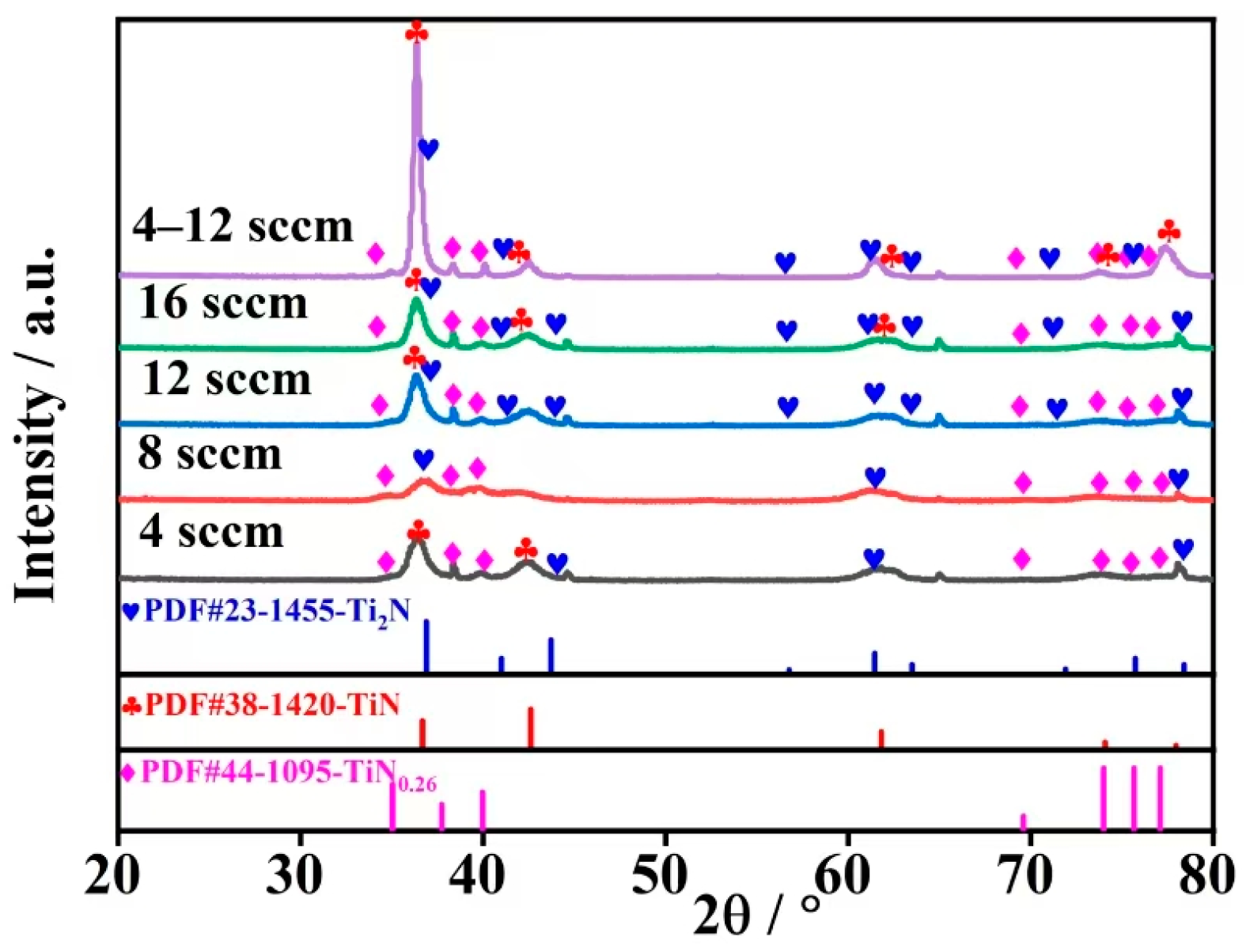
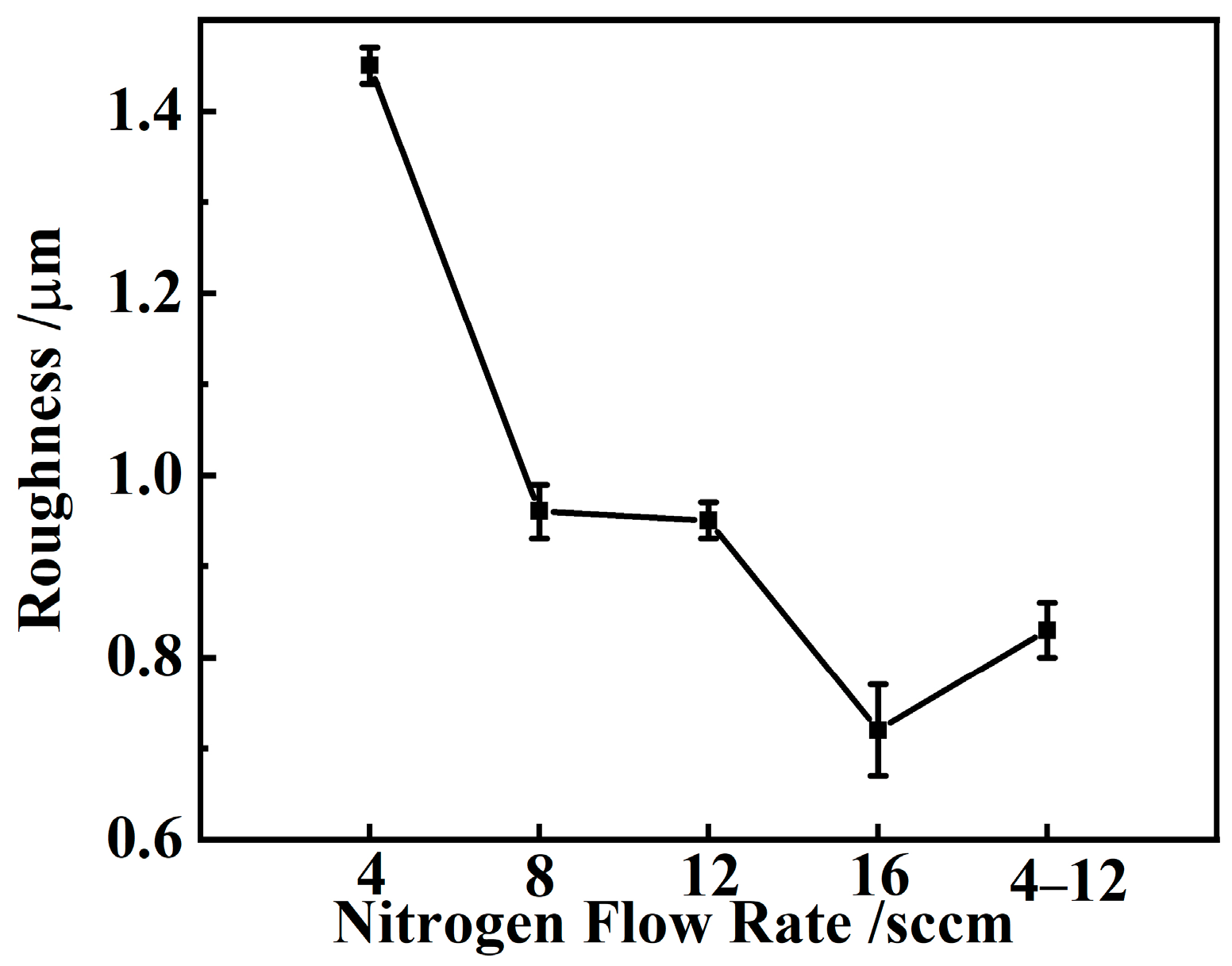

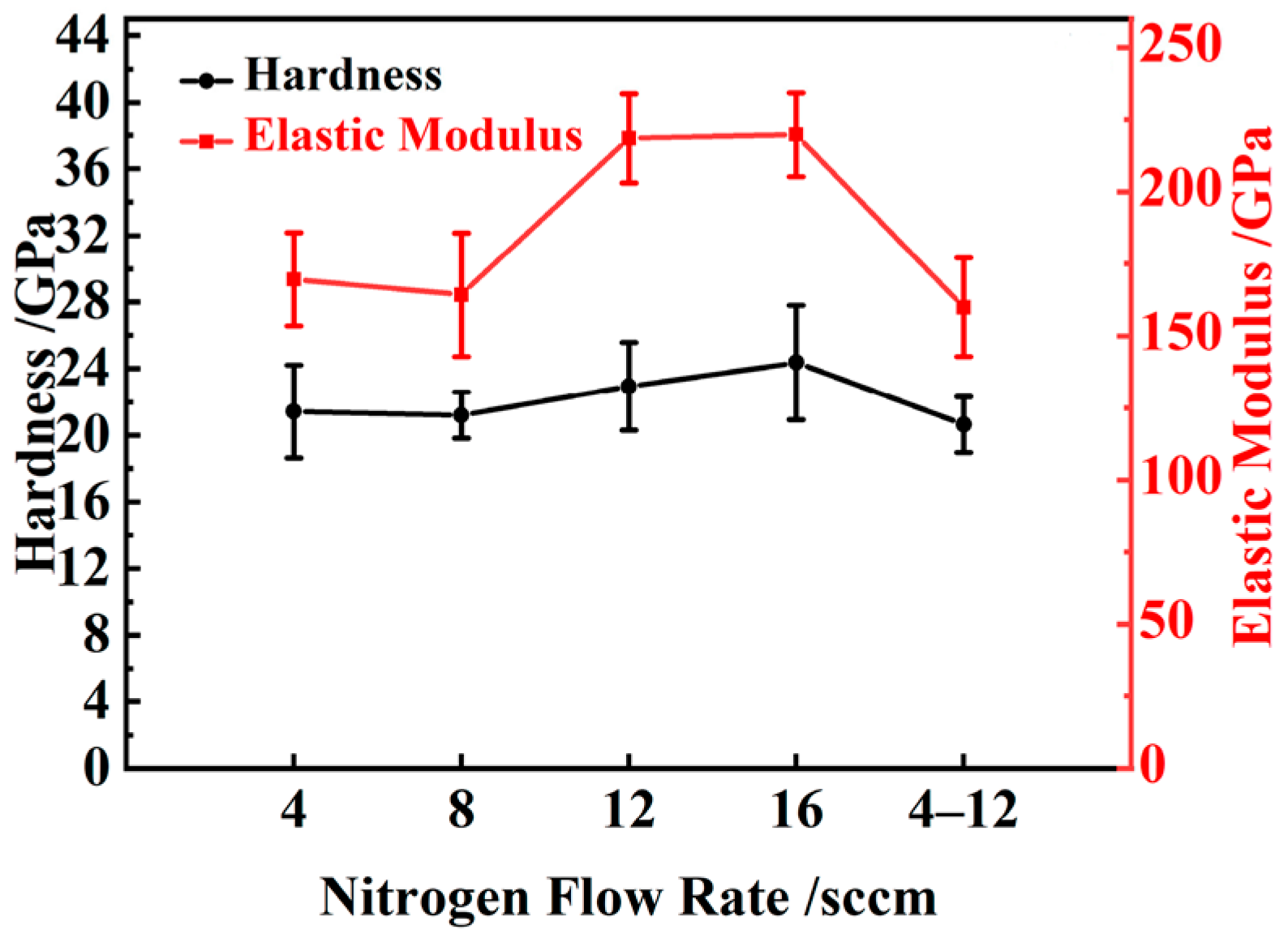

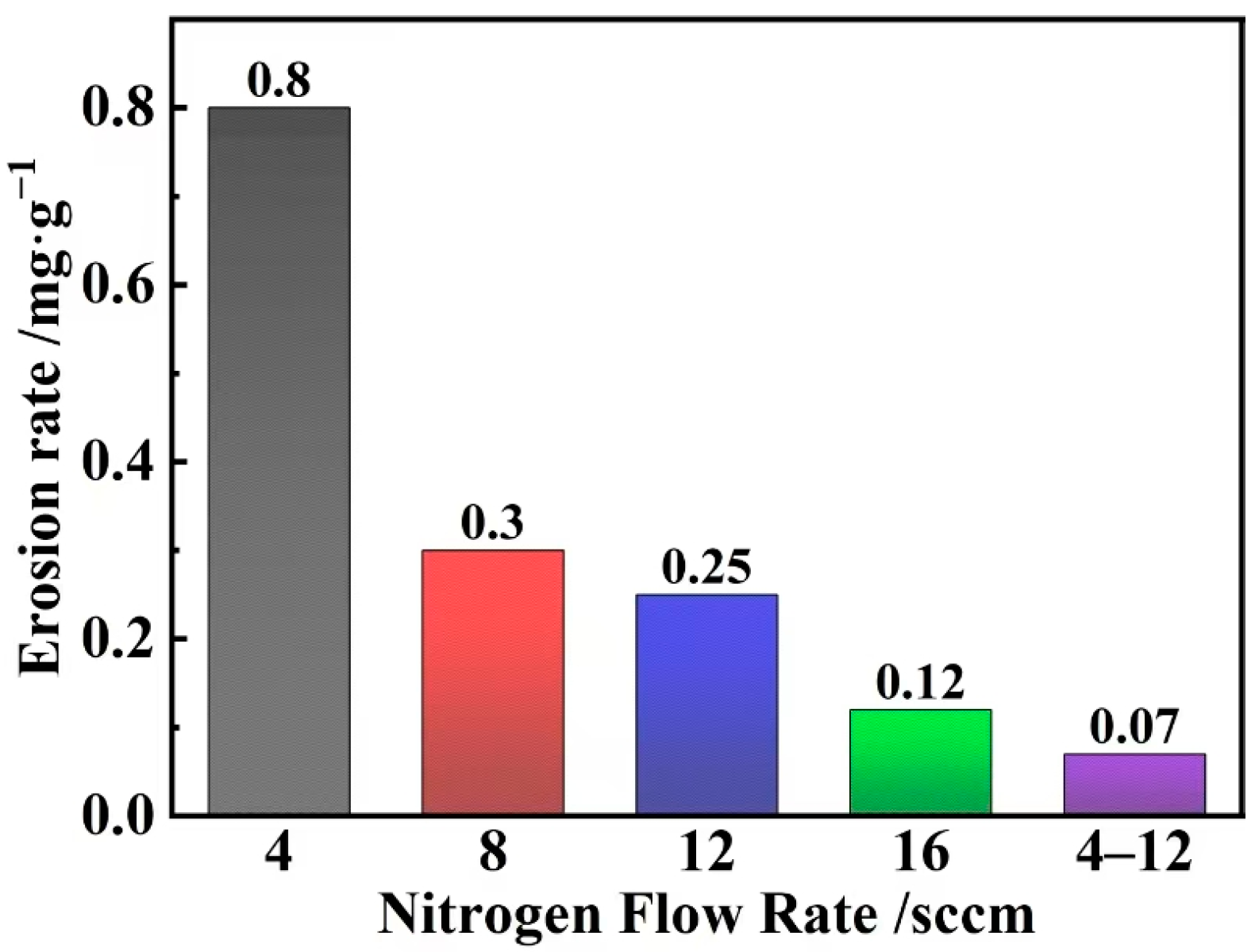
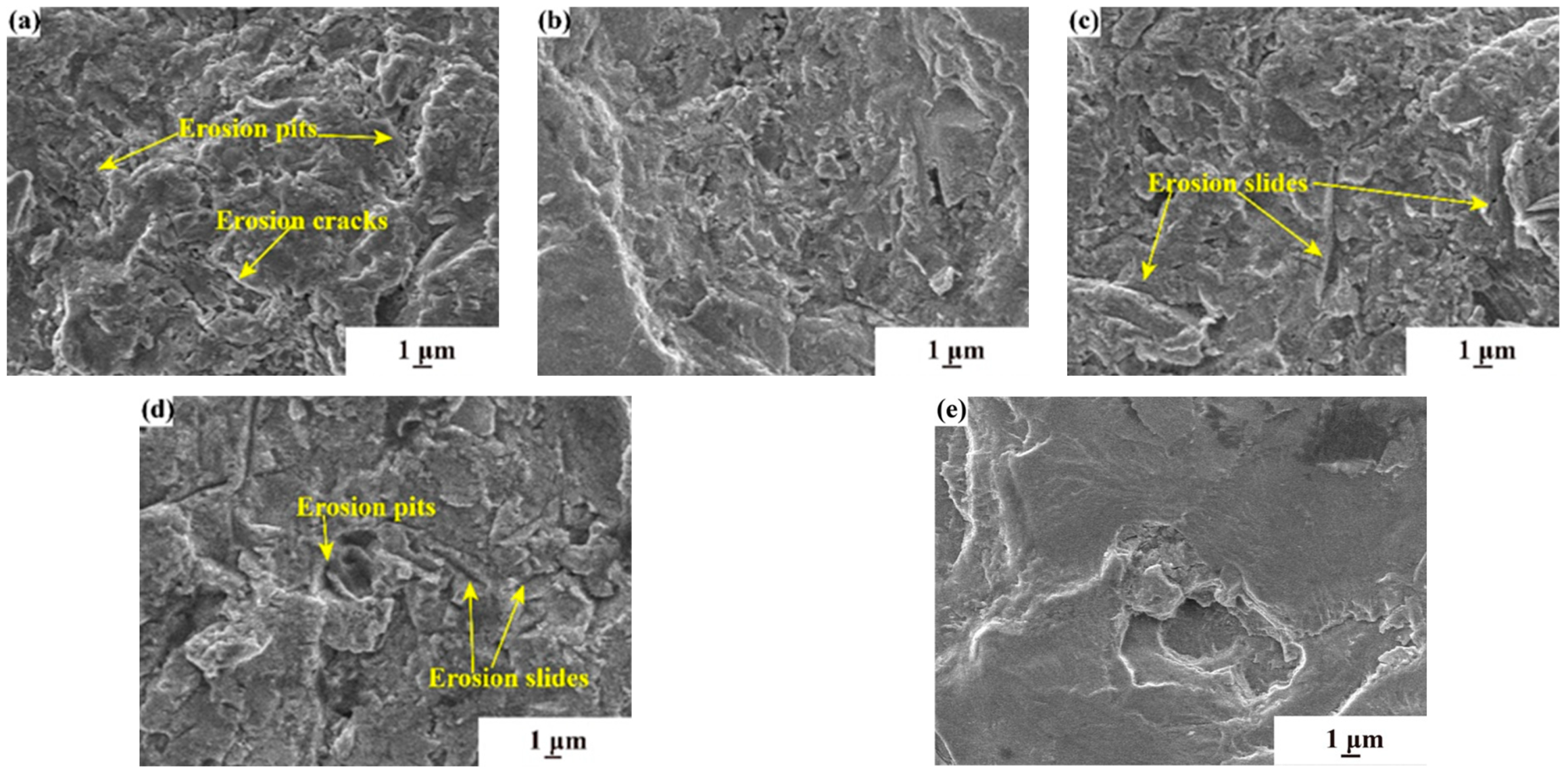
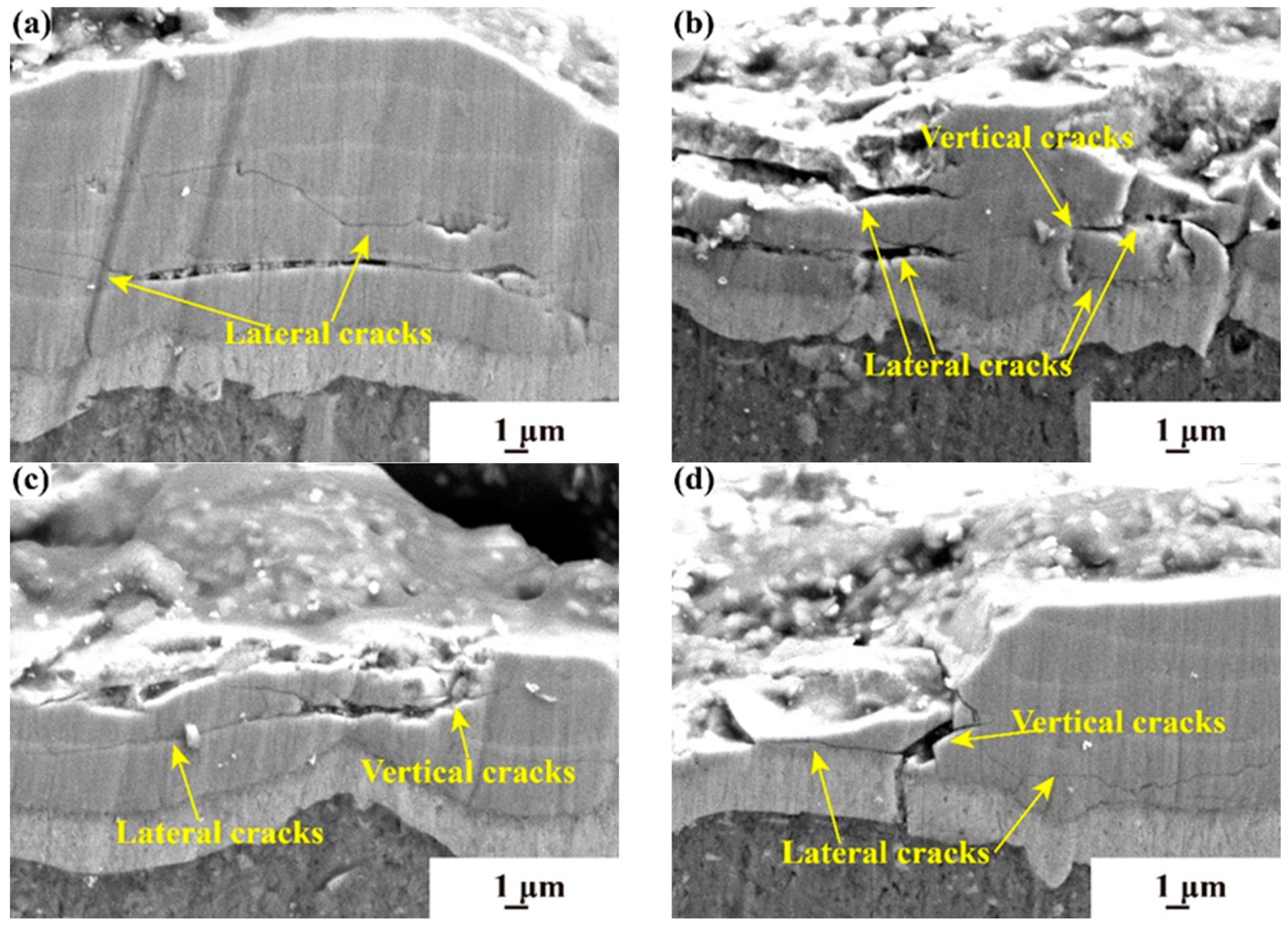


Disclaimer/Publisher’s Note: The statements, opinions and data contained in all publications are solely those of the individual author(s) and contributor(s) and not of MDPI and/or the editor(s). MDPI and/or the editor(s) disclaim responsibility for any injury to people or property resulting from any ideas, methods, instructions or products referred to in the content. |
© 2024 by the authors. Licensee MDPI, Basel, Switzerland. This article is an open access article distributed under the terms and conditions of the Creative Commons Attribution (CC BY) license (https://creativecommons.org/licenses/by/4.0/).
Share and Cite
Ren, Y.; Zhang, Z.; He, G.; Chai, Y.; Zhang, Y.; Zhang, Z. Erosion Performance of TiN/Ti Coatings under Different Nitrogen Flow Rates. Coatings 2024, 14, 1144. https://doi.org/10.3390/coatings14091144
Ren Y, Zhang Z, He G, Chai Y, Zhang Y, Zhang Z. Erosion Performance of TiN/Ti Coatings under Different Nitrogen Flow Rates. Coatings. 2024; 14(9):1144. https://doi.org/10.3390/coatings14091144
Chicago/Turabian StyleRen, Yuxin, Zhaolu Zhang, Guangyu He, Yan Chai, Yanli Zhang, and Zilei Zhang. 2024. "Erosion Performance of TiN/Ti Coatings under Different Nitrogen Flow Rates" Coatings 14, no. 9: 1144. https://doi.org/10.3390/coatings14091144




